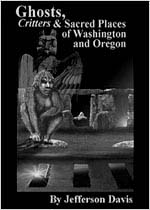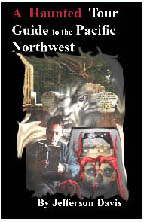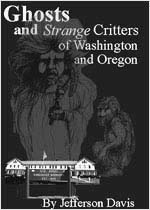|
__________
|
The Native Americans of the Pacific Northwest had a rich, varied and dynamic religion. Theologians, ethnographers and historians have written volumes about Native American spirituality. One difference between their world-view and the traditional Western view of life is the Native American view of humanity's relationship with the world. In the Native American world, man is separate from nature but human existence is dependent upon nature. This is different from the Euro-American idea that humanity stands apart from nature and can/must dominate it. Most Native Americans believed in the spirits of the dead. Although a person may have been a good friend while alive, their spirit came back after death and were regarded as bad luck. Ghosts revisited the earth every night. They would appear to friends and relatives in dreams, begging them to join them in the afterworld. The ghost cursed family and friends to kill them and take them to the spirit world. Because of the danger of ghosts, most people were buried far away from their home villages. Many of the islands on the Columbia River were used as cemeteries. That way the spirits of the dead could not cross the river to return to their former villages.
Shamanism Native Americans accepted the theory of spirit power. Their medicine men and women frequently used it to cure illnesses. Spirit mediums and psychological practices have been documented among Native Americans long before parapsychology and psychology were developed in Europe. Each person had a good and bad tamahnous or spirit following him or her. People had to merely tap into the spirit for power to help them fish or do anything better. Many spirit doctors or shamans as we call them today would advertise themselves and their power by painting a picture of their tamahnous on a board and placing it before their house. Many shamans also carried a spirit stick that aided them in performing magic. There was a similarity between the shaman's spirit stick and the wand of the medieval wizard. Many shamans had a power stick that they used as part of their magical equipment. Indian spirit sticks could even dance. Early explorers watched shamans charm their sticks, first into standing upright. Then with music and incantations the sticks rose into the air; hitting the ground in time with the music.
The Guardian in the Woods (Location Unknown) One friend described an experience she had while driving over old logging roads south of Mt. St. Helens. A friend of hers took her on a trip up to the top of a high hill. As they drove up to the summit, she felt a strong presence around her. She felt that she was not welcome. When they stopped the car at the top of the hill, her friend asked her how she felt. When she told him, he replied that he always felt the same himself when coming there. He re-counted something he had experienced before. He had been hiking up the road; as he had done many times before. This time he saw an old Indian man, in sitting at the base of a tree near the summit. He said hello and went to look at the view. From the hilltop he could see the major peaks of Loo-Wit Lat-Kla (Mt. St Helens), Wi-East (Mt. Hood); and Pa-Toe (Mt. Adams). When he turned to leave, the old Indian man spoke and asked him, "Why do you come here?" He seemed to know that the hiker came there often. The hiker replied that he liked to walk in the mountains and that this was a special place. The hiker said good-bye, and started walking down the trail. Before he went down slope, he turned for one last look. The old man had vanished.
Yacolt (Yacolt, WA) In 1902, a fire known as the Yacolt Burn spread over a hundred thousand acres and destroyed a billion board feet of timber. When it made its run up the narrow valleys of the Cascade mountains, the fire was clocked at nearly 60 miles an hour! The smoke was seen as far away as Olympia and Salem (Oregon). Residents thought that Mt. St. Helens had erupted. Although the fire never reached Yacolt, the heat from its flames was hot enough to blister paint off the walls two miles away! The traditional Indian name for the Yacolt Valley is "Yolicolb." Two translations of that name are: "haunted place" and "valley of demons." Legend has it that Indian children disappeared while picking berries there. An Indian graveyard may have been covered by the center of the town site. The strange reputation of powers existing in the valley seems to have affected the Euro-American settlers as well. At the turn of the century, the town of Yacolt had only 15 buildings and 50 inhabitants. Edgar Rotschy, an early pioneer, kept a diary from around 1890 to 1910. He wrote of at least three of the pioneers being more than just "slightly touched." In our sanity-conscious society, three crazy people might not seem like much, but given the small population, it is a large percentage.
Silver Star Mt. (Skamania County, Washington) A well known system of pits and rock piles exist on the ridge south of Silver Star Mountain, just east of the Clark County/Skamania County line in southern Washington. At least 26 pits, trenches and rock piles have been mapped by in recent years. There are several different explanations for these pits.
There is a story about a group of soldiers who were traveling from the Vancouver Barracks to Ft. Simcoe in Eastern Washington. They were ambushed and trapped on Silver Star Mt. For defense they excavated several pits and built low rock walls to protect themselves from the Native Americans. After a day or two they were able to slip away and return to the Vancouver Barracks. Pioneer stories tell of Native Americans using the pits and trenches as hunting blinds. They would wait in the pits for game being driven uphill by other hunters. It is possible that pits were dug and rocks were piled as rituals for a vision quest.
Cathapootle (Ridgefield, WA) When Lewis and Clark traveled down the Columbia River, the largest Indian Village they visited was near the City of Ridgefield. It was called Cathapootle. The area is ideally suited for settlement. It is along the Columbia River and has access to fertile, yet marshy ground nearby. This was perfect for Native American villagers. Recent archeological excavations have explored the village site. Much of the wetlands have been protected as a National Wildlife Refuge. Ridgefield grew out of the first Donation Land Claim established near the river, called Shobert’s Landing. Its name was changed to Union Ridge when Civil War veterans began settling on the high ground above the river. Later, as the town grew spread down the ridge, its name was changed to Ridgefield. Like many place in Clark County, Ridgefield has recently began to grow. Ramona Reed is a local Psychic. She has seen the ghosts of several Native Americans outside of a recent housing development in Ridgefield. She was reading a newspaper in January of 1995, when she saw the ghost of an Indian in a picture of the housing development. She and her husband drove to the development site to investigate. She reported a gathering of many Indian spirits outside of the development; all of them looked displeased. Was this their old village or burial ground? Rumor has it that construction was delayed by mysterious acts of vandalism and equipment failures. No one was ever arrested for these acts. Ramona believes that it was the spirits trying to protect their ancient land. Now that the houses have been built, do the spirits of the Indians bother their owners? I would like to know.
Copyright © 1996-2001 by Jeff Davis | Maintained by J. Goodman |






